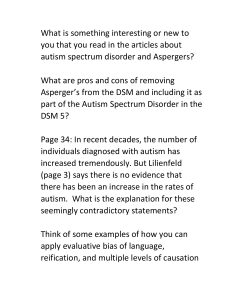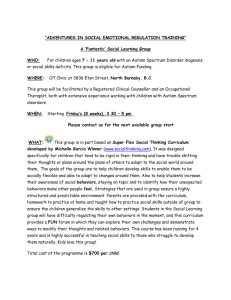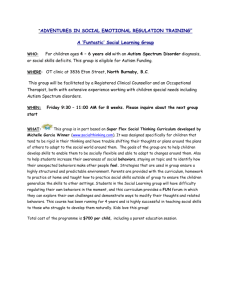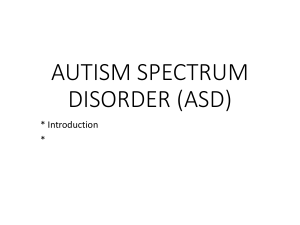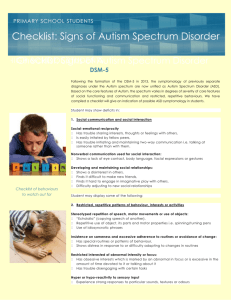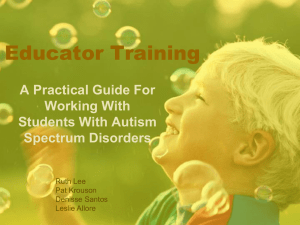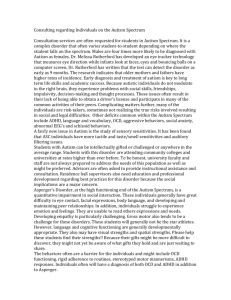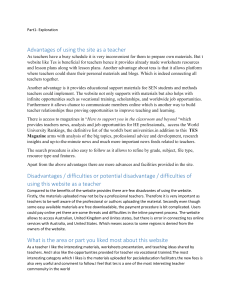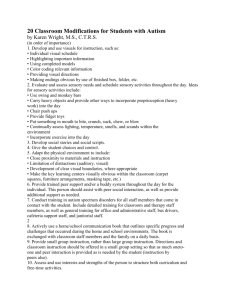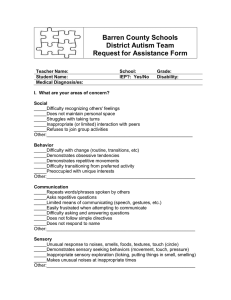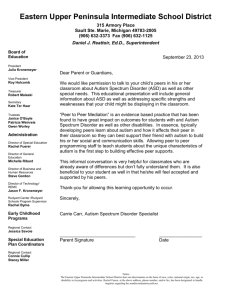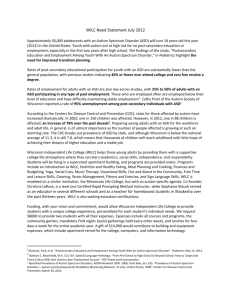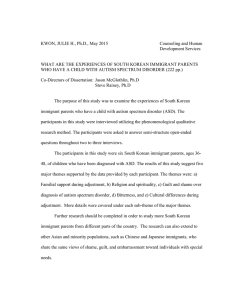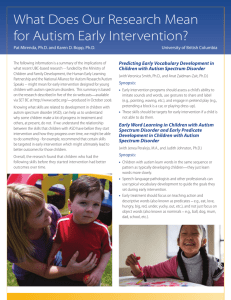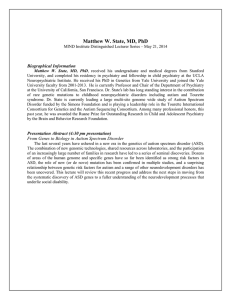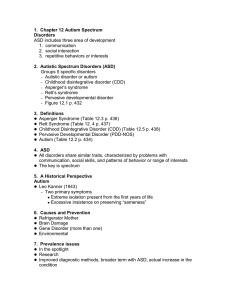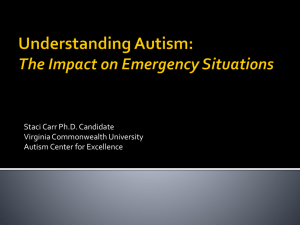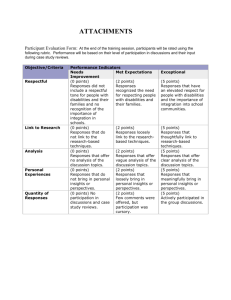6.12 Engaging Univ Personnel OSWALD RANDO
advertisement
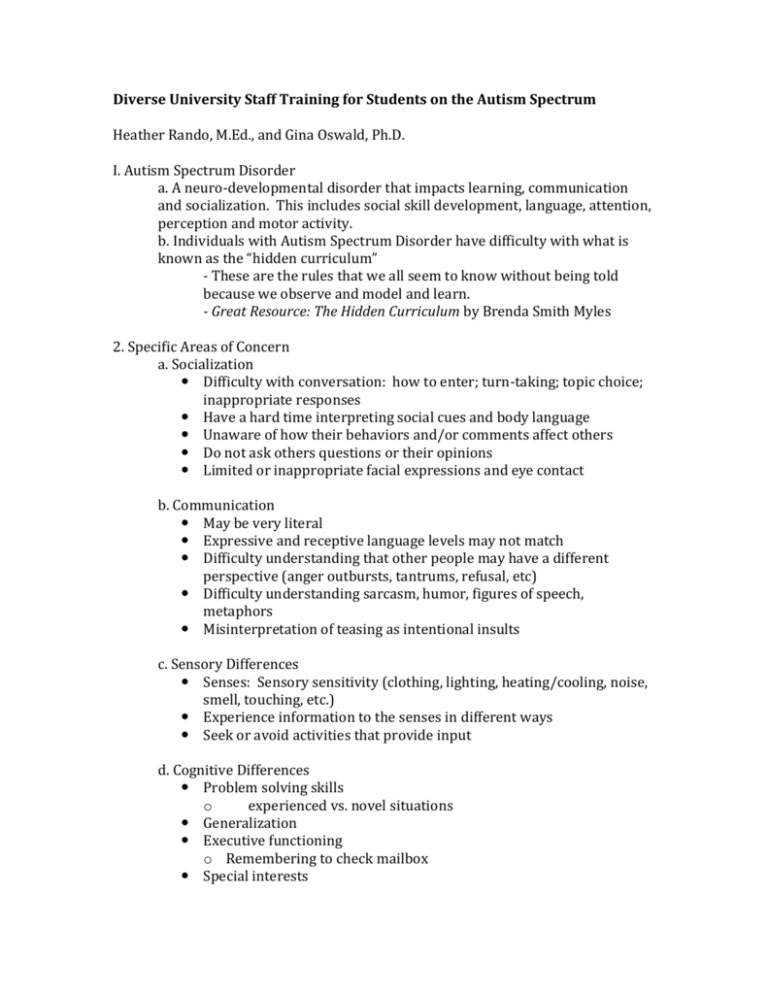
Diverse University Staff Training for Students on the Autism Spectrum Heather Rando, M.Ed., and Gina Oswald, Ph.D. I. Autism Spectrum Disorder a. A neuro-developmental disorder that impacts learning, communication and socialization. This includes social skill development, language, attention, perception and motor activity. b. Individuals with Autism Spectrum Disorder have difficulty with what is known as the “hidden curriculum” - These are the rules that we all seem to know without being told because we observe and model and learn. - Great Resource: The Hidden Curriculum by Brenda Smith Myles 2. Specific Areas of Concern a. Socialization Difficulty with conversation: how to enter; turn-taking; topic choice; inappropriate responses Have a hard time interpreting social cues and body language Unaware of how their behaviors and/or comments affect others Do not ask others questions or their opinions Limited or inappropriate facial expressions and eye contact b. Communication May be very literal Expressive and receptive language levels may not match Difficulty understanding that other people may have a different perspective (anger outbursts, tantrums, refusal, etc) Difficulty understanding sarcasm, humor, figures of speech, metaphors Misinterpretation of teasing as intentional insults c. Sensory Differences Senses: Sensory sensitivity (clothing, lighting, heating/cooling, noise, smell, touching, etc.) Experience information to the senses in different ways Seek or avoid activities that provide input d. Cognitive Differences Problem solving skills o experienced vs. novel situations Generalization Executive functioning o Remembering to check mailbox Special interests Average to above average intelligence, are often gifted in their area of intense interest e. Emotional Differences Difficulty identifying and understanding feelings Trouble reading emotional situations Co-morbid mental health issues o Anxiety/depression o Low frustration tolerance o Need for bullying awareness and prevention Boundary issues related to interpersonal relationships 3. Tips for Working with Individuals with ASD a. Strengths Punctual Comfort with repetitive tasks Loyal Do not like to break rules Avoid gossip Think outside the box Predictable Attention to detail Honest Follow procedures consistently Rare absences Creative Excellent memory Precise and Informative b. Restricted Patterns of Behavior, Interests, and Activities Need for consistency and structure Routines are helpful and preferred Narrow area of interest Repetitive motor behaviors Explicit explanation of rules Explain why behaviors are inappropriate c. Strategies Proactively educate the student on the rules and guidelines for specific encounters; meetings with faculty, classroom behavior (specifically asking questions and talking during class), roommate concerns. Use scripting for class time or any time that there is an expectation of a certain type of behavior. It provides clarity and consistency for the student Be aware that students with ASD may need more personal space than is typical Be sensitive to and aware of sensory environment (noises, odors, volume of audio, heating/cooling, etc.) Be careful not to use idiom or metaphoric language; be very literal State communications verbally that might ordinarily be communicated non-verbally Be aware of their heightened sense of anxiety, depression, etc. Make corrections in the moment in a clear and concise manner and directly refer to an established rule. Strategies that have been most successful in the past for classroom disruption prevention often involve trying to proactively manage this type of behavior by clearly outlining classroom rules. Students with autism typically respond to and seek to know what the rules are for situations that they encounter. They can also interpret statements quite literally, so an innocent comment by the professor on the first day of class while going over the syllabus such as “If you ever have any questions, please don’t hesitate to ask”, can lead to multiple questions during class because they perceive they have been told it is okay. Encourage the faculty member(s) to set up a meeting with the student as soon as possible to discuss ways they can work together to help the student to be successful in the class. The faculty member can say something like “I notice you seem to have a lot of questions during class and I want to make sure you are getting the answers you need without feeling frustrated. In order to best do this, here is how I think we can solve the problem – If you (student) have questions in class, please write them down on a piece of paper. At the end of each class, if they haven’t been answered by later parts of the lecture or a class activity, rank the top three and either hand them to me after class or send them to me by email. I will answer them within 24 hours.” It will also be important for the faculty member to be very direct about how the current behavior is not acceptable in the classroom because it is disrupting the learning environment of the other students in the class, which if continued, could result in a referral to student conduct. It is okay to be direct, and this is preferred by students with autism, because ambiguity and extra words to soften things often cloud the picture and confuse the student. The faculty member(s) can also offer a suggestion that the student quietly get up to excuse himself for a restroom/composure break when he is feeling frustrated. That way the faculty member will not need to redirect the student during class and potentially have the student behavior escalate. An important thing to keep in mind - the student needs to be actively involved in the process of creating a plan for his success to ensure that he will be compliant. If he is not actively involved, he may initially agree, but later be noncompliant because he doesn’t see the value in doing the activity. Student buy-in is critical for success.
